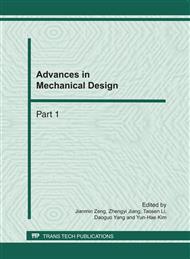[1]
Chen H K, Tang H M, Chen Y Y. Mechanics of debris flow along highway. Beijing: The Science Press, 2007. (in Chinese).
Google Scholar
[2]
Wu J S, Tian L Q, Kang Z C, et al. Debris flow and comprehensive management. Beijing: The Science Press, 1993. (in Chinese).
Google Scholar
[3]
Zhang S C. A review on the research of debris flow. Advances in Mechanics, 1989, 19(3): 365-375. (in Chinese).
Google Scholar
[4]
Chen H K, Tang H M, Ye S Q. Study on debris flows along highways in China. The Chinese Journal of Geological Hazard and Control, 2008, 19(1): 1-5. (in Chinese).
Google Scholar
[5]
Wu J S. Observations and studies on debris flow in Jiangjiagou, Yunnan province. Beijing: The Science Press, 1990. (in Chinese).
Google Scholar
[6]
Liu L J, Wei H. Study of impace of debris flow. Journal of Sichuan Union University (Engineering Science Edition), 1997, 1(2): 99-102. (in Chinese).
Google Scholar
[7]
Wei H. Experimental study on wallop of debris flow heads. China Railway Science, 1996, 17(3): 50-62. (in Chinese).
Google Scholar
[8]
Zhang Y, Wei F Q, Wang Q. Wallop calculation of viscous debris flow based momentum conservation. Journal of Sediment Research, 2006, (3): 23-26. (in Chinese).
Google Scholar
[9]
Valentino R, Barla G, Montrasio L. Experimental analysis and micromechanical modeling of dry granular flow and impacts in laboratory flume tests. Rock Mechanics and Rock Engineering, 2008, 41(1): 153-177.
DOI: 10.1007/s00603-006-0126-3
Google Scholar
[10]
Armento M C, Genevois R, Tecca P R. Comparison of numerical models of two debris flows in the Cortina d'Ampezzo area, Dolomites, Italy. Landslides, 2008, (5): 143-150.
DOI: 10.1007/s10346-007-0111-2
Google Scholar
[11]
Chen H K, Du R H, Tang H M, Wang Q C. Study on blasting mechanism of high pressure core in debris flow. Journal of Chongqing Jiaotong University(Natural Science), 2008, 27(5): 790-793. (in Chinese).
Google Scholar
[12]
Chen H K, Tang H M, Wu S F. Research on abrasion of debris flow to high-speed drainage structure. Applied Mathematics and Mechanics, 2004, 25(11): 1257-1264.
DOI: 10.1007/bf02438281
Google Scholar
[13]
Chen H K, Tang H M. Method to calculate wallop and impact time of two-phase debris flow. China Journal of Highway and Transport, 2006, 19(3): 19-23. (in Chinese).
Google Scholar
[14]
Chen H K, Tang H M. Essential principle of debris flow dynamics. WSEAS Transactions on Fluid Mechanics, 2006, 10(1): 932-936.
Google Scholar


